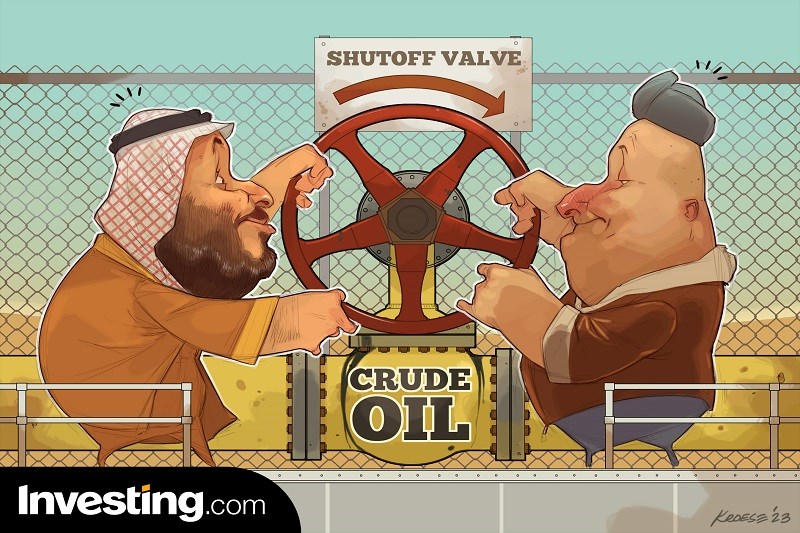Investing.com - Oil prices rise again this Thursday. The WTI is trading at $74 and the Brent at $79. Experts are already analyzing what we can expect from this raw material in 2024.
Michael Salden, director of raw materials at Vontobel (SIX:VONN), points out that "the reality is that the market continues to give signs that there is excess oil and this has reacted with declines both to the announcement of cut production of OPEC and the escalation of war in the Middle East".
"At the moment, tensions in Gaza remain contained and have not affected global oil trade flows. In this scenario, the geopolitical risk premium of oil and gold has vanished and oil has fallen from levels of just over 90 dollars to just over 70 dollars (WTI oil)", points out this expert.
What can aggravate the situation?
In the United States, the House of Representatives approved the SHIP law (Stop Harboring Iranian Petroleum Act), which imposes new sanctions on entities involved in the transportation of Iranian oil and would require the Administration to submit an annual report to Congress on exports of Iran and its oil trade with China. "In this case, international ports and intermediaries that support Iranian flows can also be directly targeted. There is a high probability that this law will be applied by the current administration, reducing the flow of Iranian oil exports to Asia with great discounts," says Salden.
"It should also be noted that the US is entering an election year, which could explain why the US provided some relief to Venezuelan exports. This shows that the US administration will be committed to employing multiple resources to keep gasoline prices at the pumps under control," he adds.
Is a reduction in demand for raw materials expected?
Demand for raw materials continues to grow even in a weak growth scenario, says Salden. "That is, demographic growth and income growth in non-OECD countries more than compensate for the weakness of the European GDP trend," says this expert.
According to Salden, this year oil demand increases approximately +2.5 million barrels of oil per day year-on-year (=2.3% annual growth) and next year the figure will exceed +0.7 million barrels of oil per day. Although OPEC remains optimistic and continues to see 2.4 million barrels of oil per day also in 2024. Both years China is the key driver of oil demand. Given weak Chinese growth, we expect more stimulus measures to arrive and the 5% growth target to be defended.
Oil outlook
According to Salden, these are the reasons for the recent weakness of oil:
- Disappearance of the geopolitical risk premium
- Chinese oil imports have been strong this year, but the extent to which China is (opportunistically) taking advantage of cheap exports from Iran and Russia remains unclear.
- Exports from OPEC and Russia were weak over the summer and contributed to lower global gasoline inventories. Looking ahead, these exports are likely to rebound as domestic demand will decline (seasonally) and there will be a rebound in OPEC seaborne crude oil exports, particularly from Saudi Arabia.
- Supplies from non-OPEC countries (USA, Canada, Guyana, Brazil, Nigeria) exceed expectations.
The high excess capacity (approximately 5 million barrels per day) of OPEC members and Russia introduces risks of non-compliance with the quota. - The market is already taking into account that Saudi Arabia and Russia must extend production cuts until the second quarter of 2024. That is, PEC+ will have to maintain the production plan for the fourth quarter of 2023 (or something similar) in the first quarter 2024 to avoid a surplus. This means that Saudi Arabia will maintain its production cut of 1 million barrels per day, keeping production at 9 million barrels per day. It means Russia maintains its "supply" cut of 300 kb/d, keeping crude oil production around 9.6 mb/d.
- Russian exports appear to be recovering from the ban on diesel exports this summer.
Investor positioning
"The positioning of oil investors is extremely bearish, which leaves room for further increases in the event of production problems, geopolitical tensions or a production cut by Saudi Arabia," highlights Salden.
"Thus, bearish investors will question OPEC's role in balancing the markets and how long it will hold firm on its production quota. Implicitly, the market is already factoring in that Saudi Arabia will maintain the cut production by 1 million barrels of oil per day for the entire first half, and perhaps move to a cut of half a million barrels of oil per day in the second half of 2024. Maintain OPEC+ production at levels current prices in the first quarter of 2024 seems feasible for OPEC+ and would keep the market balanced and prices around 80 points," he concludes.
Translated from Spanish using DeepL.
Have you heard of a Santa Claus Rally?
Read more about how this end-of-year phenomenon can help with your trading.
Which stock should you buy in your very next trade?
AI computing powers are changing the stock market. Investing.com's ProPicks AI includes 6 winning stock portfolios chosen by our advanced AI. In 2024 alone, ProPicks AI identified 2 stocks that surged over 150%, 4 additional stocks that leaped over 30%, and 3 more that climbed over 25%. Which stock will be the next to soar?
Unlock ProPicks AI

